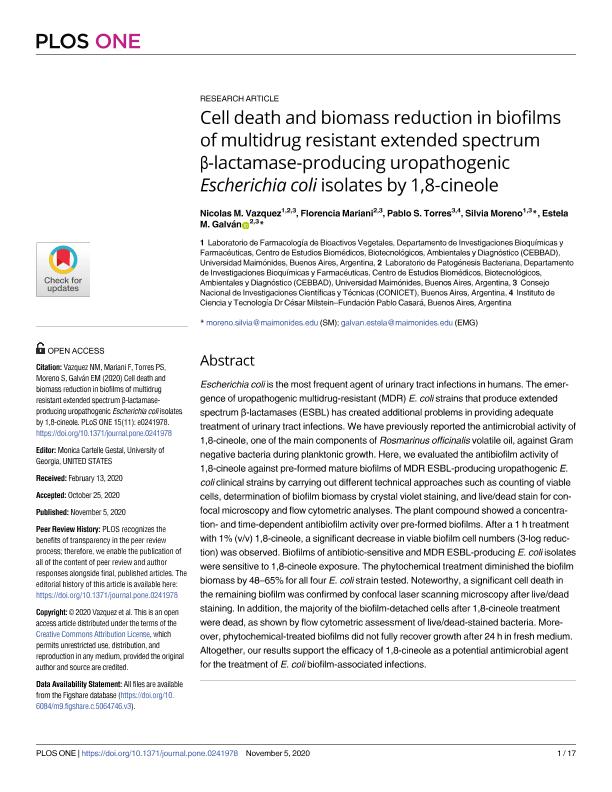Artículo
Cell death and biomass reduction in biofilms of multidrug resistant extended spectrum β-lactamase-producing uropathogenic Escherichia coli isolates by 1,8-cineole
Vázquez, Nicolás Martín ; Mariani, Florencia
; Mariani, Florencia ; Torres, Pablo Sebastian
; Torres, Pablo Sebastian ; Moreno, Silvia
; Moreno, Silvia ; Galvan, Estela Maria
; Galvan, Estela Maria
 ; Mariani, Florencia
; Mariani, Florencia ; Torres, Pablo Sebastian
; Torres, Pablo Sebastian ; Moreno, Silvia
; Moreno, Silvia ; Galvan, Estela Maria
; Galvan, Estela Maria
Fecha de publicación:
11/2020
Editorial:
Public Library of Science
Revista:
Plos One
ISSN:
1932-6203
e-ISSN:
1932-6203
Idioma:
Inglés
Tipo de recurso:
Artículo publicado
Clasificación temática:
Resumen
Escherichia coli is the most frequent agent of urinary tract infections in humans. The emergence of uropathogenic multidrug-resistant (MDR) E. coli strains that produce extended spectrum β-lactamases (ESBL) has created additional problems in providing adequate treatment of urinary tract infections. We have previously reported the antimicrobial activity of 1,8-cineole, one of the main components of Rosmarinus officinalis volatile oil, against Gram negative bacteria during planktonic growth. Here, we evaluated the antibiofilm activity of 1,8-cineole against pre-formed mature biofilms of MDR ESBL-producing uropathogenic E. coli clinical strains by carrying out different technical approaches such as counting of viable cells, determination of biofilm biomass by crystal violet staining, and live/dead stain for confocal microscopy and flow cytometric analyses. The plant compound showed a concentration- and time-dependent antibiofilm activity over pre-formed biofilms. After a 1 h treatment with 1% (v/v) 1,8-cineole, a significant decrease in viable biofilm cell numbers (3-log reduction) was observed. Biofilms of antibiotic-sensitive and MDR ESBL-producing E. coli isolates were sensitive to 1,8-cineole exposure. The phytochemical treatment diminished the biofilm biomass by 48-65% for all four E. coli strain tested. Noteworthy, a significant cell death in the remaining biofilm was confirmed by confocal laser scanning microscopy after live/dead staining. In addition, the majority of the biofilm-detached cells after 1,8-cineole treatment were dead, as shown by flow cytometric assessment of live/dead-stained bacteria. Moreover, phytochemical-treated biofilms did not fully recover growth after 24 h in fresh medium. Altogether, our results support the efficacy of 1,8-cineole as a potential antimicrobial agent for the treatment of E. coli biofilm-associated infections.
Archivos asociados
Licencia
Identificadores
Colecciones
Articulos(SEDE CENTRAL)
Articulos de SEDE CENTRAL
Articulos de SEDE CENTRAL
Citación
Vázquez, Nicolás Martín; Mariani, Florencia; Torres, Pablo Sebastian; Moreno, Silvia; Galvan, Estela Maria; Cell death and biomass reduction in biofilms of multidrug resistant extended spectrum β-lactamase-producing uropathogenic Escherichia coli isolates by 1,8-cineole; Public Library of Science; Plos One; 15; 11; 11-2020; 1-17
Compartir
Altmétricas



